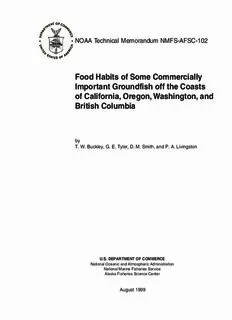
Food habits of some commercially important groundfish off the PDF
Preview Food habits of some commercially important groundfish off the
NOAA Technical Memorandum NMFS-AFSC-102 Food Habits of Some Commercially Important Groundfish off the Coasts of California, Oregon, Washington, and British Columbia by T. W. Buckley, G. E. Tyler, D. M. Smith, and P. A. Livingston U.S. DEPARTMENT OF COMMERCE National Oceanic and Atmospheric Administration National Marine Fisheries Service Alaska Fisheries Science Center August 1999 NOAA Technical Memorandum NMFS The National Marine Fisheries Service's Alaska Fisheries Science Center uses the NOAA Technical Memorandum series to issue informal scientific and technical publications when complete formal review and editorial processing are not appropriate or feasible. Documents within this series reflect sound professional work and may be referenced in the formal scientific and technical literature. The NMFS-AFSC Technical Memorandum series of the Alaska Fisheries Science Center continues the NMFS-F/NWC series established in 1970 by the Northwest Fisheries Center. The new NMFS-NWFSC series will be used by the Northwest Fisheries Science Center. This document should be cited as follows: Buckley, T. W., G. E. Tyler, D. M. Smith, and P. A. Livingston. 1999. Food habits of some commercially important groundfish off the coasts of California, Oregon, Washington, and British Columbia. U.S. Dep. Commer., NOAA Tech. Memo. NMFS-AFSC-102, 173 p. Reference in this document to trade names does not imply endorsement by the National Marine Fisheries Service, NOAA. NOAA Technical Memorandum NMFS-AFSC-102 Food Habits of Some Commercially Important Groundfish off the Coasts of California, Oregon, Washington, and British Columbia by 2 T. W. Buckley, G. E. Tyler D. M. Smith’, and P. A. Livingston’ Alaska Fisheries Science Center 1 Resource Ecology and Fisheries Management Division 7600 Sand Point Way N.E., BIN C-15700 Seattle, WA 98115-0070 2 University of Washington School of Fisheries Box 357980 Seattle, WA 98195 U.S. DEPARTMENT OF COMMERCE William M. Daley, Secretary National Oceanic and Atmospheric Administration D. James Baker, Under Secretary and Administrator National Marine Fisheries Service Penelope D. Dalton, Assistant Administrator for Fisheries August 1999 This document is available to the public through: National Technical Information Service U.S. Department of Commerce 5285 Port Royal Road Springfield, VA 22161 Notice to Users of this Document This document is being made available in .PDF format for the convenience of users; however, the accuracy and correctness of the document can only be certified as was presented in the original hard copy format. iii ABSTRACT This report describes the food habits of some commercially important groundfish collected off the coasts of California, Oregon, Washington, and British Columbia. Generally, the groundfish reported on were sampled during three cruises - the triennial groundfish survey of 1989 and the continental slope surveys of 1991 and 1992. Some young-of-the-year Pacific hake (also known as Pacific whiting, Merluccius productus) were examined from 1987 and 1988 surveys. Where possible, the diet of each groundfish species was examined for possible ontogenetic, latitudinal, depth, and seasonal changes. Typically, ontogenetic shifts in the diet of the predators examined on this study were based on the ability of the larger fish to eat larger prey. Effects of latitude, depth, and season were also detected for some of these species. The diet of age-0 Pacific hake shifted from copepods to euphausiids with increasing size (33-128 mm total length) in 1987, but not in 1988. Pacific hake became increasingly piscivorous with size, and cannibalism was an important diet component in 1991 in the Monterey INPFC (International North Pacific Fisheries Commission) statistical area. Sablefish (Anoplopoma fimbria) and shortspine thornyhead (Sebastolobus alascanus) consumed a wide variety of locally abundant prey items including large amounts of offal from fish-processing operations conducted at sea. The diet of juvenile sablefish captured over the continental shelf was similar to the diet of Pacific hake, but the diet of larger sablefish sampled from the upper continental slope was more similar to the shortspine thornyhead diet. Arrowtooth flounder (Atheresthes stomias) was the most piscivorous predator examined in this study, consuming mostly Pacific hake, Pacific herring (Clupea pallasi) and unidentified gadids. Longspine thornyhead (S. altivelis) consumed a variety of benthic crustaceans, and the presence of fishery offal in the diet indicated that longspine thornyhead also scavenged the slope bottom. Giant grenadier (Albatrossia pectoralis) consumed mostly deepwater crustaceans and fishes in this study, by weight. Pacific grenadier (Coryphaenoides acrolepis) stomachs contained mostly squid and a variety of crustaceans, by weight. A majority of the diet of Dover sole (Microstomuspaczjkus) and deepsea sole (Embassichthys bathybius) was polychaete worms and brittlestars. V CONTENTS Page ABSTRACT ...................................................... iii INTRODUCTION ................................................. 1 METHODS ....................................................... 1 RESULTS and DISCUSSION. ....................................... 6 Young-of-the-year Pacific Hake ................................ 6 Pacific Hake ................................................ 11 Sablefish . . . . . . . . . . . . . . . . . . . . . . . . . . . . . . . . . . . . . . . . . . . . . . . . . . 25 ShortspineThornyhead ....................................... 43 LongspineThornyhead ....................................... 57 GiantGrenadier ............................................. 65 Pacific Grenadier ............................................ 71 Dover Sole . . . . . . . . . . . . . . . . . . . . . . . . . . . . . . . . . . . . . . . . . . . . . . . . . 77 Deepsea Sole ............................................... 93 Arrowtooth Flounder ........................................ 99 Species Interactions ......................................... 107 ACKNOWLEDGEMENTS ......................................... 123 CITATIONS . . . . . . . . . . . . . . . . . . . . . . . . . . . . . . . . . . . . . . . . . . . . . . . . . . . . . 124 APPENDIX ...................................................... 131
Description: